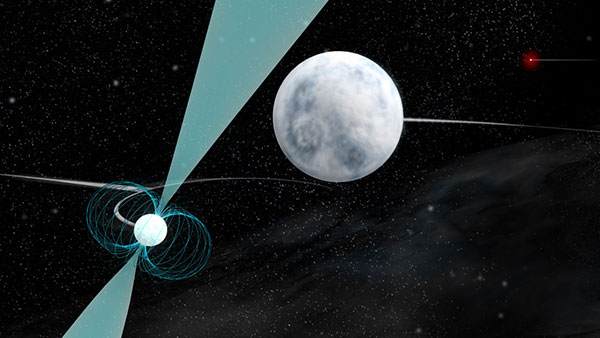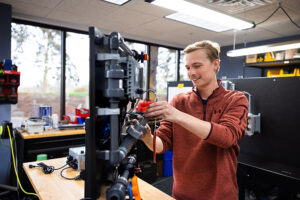
When David Kaplan and collaborators complete their analysis on a recently discovered and unique pulsar grouping, what they find could settle an important question about the nature of gravity that Albert Einstein proposed.
Kaplan, an assistant professor of physics at the University of Wisconsin-Milwaukee (UWM), is part of an international team of astronomers who have detailed their discovery of this stellar triple system, consisting of two white dwarf stars and a pulsar, all packed within a space smaller than Earth’s orbit around the Sun.
This animation shows the unique triple-star system with a superdense neutron star and two white dwarf stars. The neutron star is a pulsar, emitting lighthouse-like beams of radiation as it spins on its axis. These beams, in blue, are seen sweeping through space as the neutron star rotates. At the start, you see this pulsar and its close companion white dwarf in orbit around their common center of mass. The animation zooms outward, showing this pair also in orbit with a more-distant, cooler white dwarf, and illustrates the motions of these three bodies. The entire system would fit within Earth’s orbit around the Sun. (Bill Saxton (NRAO/AUI/NSF).Watch full-size video
The team, led by Scott Ransom of the National Radio Astronomy Observatory (NRAO), outlines the discovery in a paper published online Jan. 5 in the journal Nature . The closeness of the stars, combined with their nature, has allowed the scientists to make the best measurements yet of the complex gravitational interactions in such a system.
Kaplan’s role was to home in on a more precise location for the grouping and to identify the other two objects near the pulsar, a rapidly spinning, super-dense neutron star that is so massive it has collapsed in on itself.
The dying star emits radio waves in a form that resembles a lighthouse beam that can be seen with a radio telescope as a pulse for every rotation it makes. In this case, the pulsar rotates every three milliseconds.
“This is the first millisecond pulsar found in such a system, and we immediately recognized that it provides us a tremendous opportunity to study the effects and nature of gravity,” Ransom says. Gravity has a powerful effect on neutron stars, says Kaplan, who likens the difference between a neutron star and a white dwarf to “going from the size of the Earth to the size of Milwaukee.”
White dwarfs are considerably less massive stellar remnants that shine for billions of years, cooling as they age. Measuring the temperature allowed Kaplan to estimate the age of one of the white dwarfs as only about 100 million years: quite young compared to many pulsars, which may be billions of years old.
In fact, it was this white dwarf that helped Kaplan locate the pulsar, which is in our Milky Way galaxy, but about 4,000 light-years away.
Within the range of sky indicated by the Green Bank Telescope (GBT) in West Virginia, which was used to find the pulsar, Kaplan used ultraviolent light to identify a star with a blue tint as a young and hot white dwarf.
These data also show that the hot white dwarf is the inner member of the triple. Both it and the pulsar orbit around a second white dwarf.
“We know they are together because in tracking the orbits, the points agree with the pulsar’s radio data,” says Kaplan.
The pulses, along with Kaplan’s optical data, will provide precision tools to test a tenet of Einstein’s Theory of General Relativity called the equivalence principle – that objects being pulled by gravity move at the same rate, regardless of their respective masses.
One of the most famous experiments illustrating the equivalence principle occurred in 1971 when Apollo 15 Commander Dave Scott dropped a hammer and a falcon feather while standing on the airless surface of the Moon.
“If the pulsar and closer white dwarf are ‘falling’ toward the outer white dwarf at the same rate, then Einstein was right,” Kaplan says.
“While Einstein’s Theory of General Relativity has so far been confirmed by every experiment, it is not compatible with quantum theory. Because of that, physicists expect that it will break down under extreme conditions,” says Ransom.
The scientists began an intensive observational program using the GBT, the Arecibo radio telescope in Puerto Rico, and the Westerbork Synthesis Radio Telescope in the Netherlands. They also studied the system using data from the Sloan Digital Sky Survey, the GALEX satellite, the WIYN telescope on Kitt Peak, Arizona, and the Spitzer Space Telescope. Kaplan has studied the system further using the Gemini telescope on Mauna Kea, Hawaii.
The NRAO and GBT are facilities of the National Science Foundation, operated under cooperative agreement by Associated Universities Inc.
###
(CONTACTS: At UWM, David Kaplan, 414-229-4971, kaplan@uwm.edu. At NRAO, Scott Ransom, 434 296 0320







